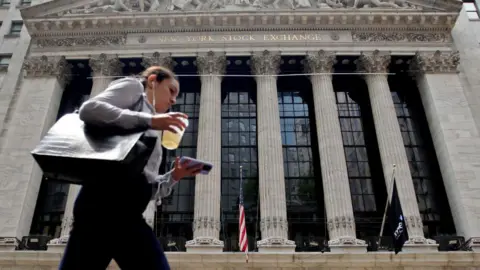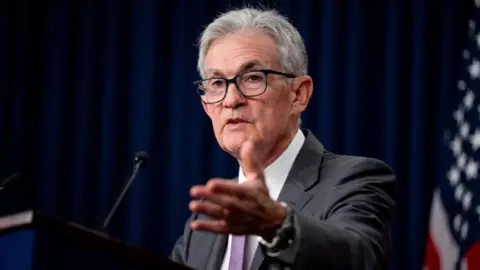What would a US Federal Reserve interest rate cut mean for me?

 Getty Images
Getty ImagesThe U.S. central bank is set to cut interest rates for the first time in four years on Wednesday, a historic moment for the world’s largest economy.
The highly anticipated move will impact mortgage, credit card and savings rates for millions of people in the United States – and even around the world.
We won’t know exactly how deep the Fed will cut, or how far rates might go, until after the announcement.
So what does this mean for you?
What does a reduction mean for mortgages, car loans and other debts?
The Federal Reserve’s policy rate (the rate it charges banks to borrow) sets the basis for what businesses charge individuals in the United States for loans, such as mortgages, or other debts, such as unpaid credit card balances.
The rate has been hovering around 5.3% for more than a year, the highest level since 2001, after jumping from near zero in early 2022.
A rate cut will provide welcome relief for borrowers, although it will likely mean some banks will also cut the rates they offer savers.
Mortgage rates in the United States have already fallen slightly, partly in anticipation of the move.
What could be the overall impact?
 Getty Images
Getty ImagesAmericans will be most directly affected by such a change. But central banks with currencies tied to the dollar often tie their rate decisions to the Fed, such as Hong Kong and many Gulf states, so borrowers in those countries will also be affected.
For the many people outside the United States who have invested in the U.S. stock market, a decline is also likely good news.
Lower interest rates tend to boost stock prices for two reasons.
First, it means companies can borrow debt more cheaply and reinvest it to make the business more profitable.
Second, lower rates mean that savings accounts and some other types of investments become less attractive, so investors tend to move their money into things like stocks.
Why might the Fed cut rates this time?
Compared to other central banks, the Fed is a little late to the rate-cutting party.
Europe, the UK, New Zealand and Canada have already cut rates, as have many emerging market banks.
These banks all had their own reasons for cutting rates, and the Fed’s decision to cut rates depends in part on what is driving it to act.
The Fed raises or lowers rates in response to two factors: inflation and employment.
In 2022, when the Fed began raising interest rates, officials were focused on inflation and trying to stabilize consumer prices, which were rising at the fastest pace since the 1980s.
Rising rates tend to lower prices by making it harder to borrow, so people spend less on everything from consumer goods to housing and business equipment.
But lower demand also means the economy isn’t growing as quickly, and if it slows too much and actually starts to contract, then that’s a recession.
In the past, the U.S. economy has often fallen into recession after a series of rate hikes, costing millions of people their jobs.
Over the past year, unemployment in the United States has risen, while hiring has slowed sharply.
Is the Fed cutting rates because it has won its fight against inflation or because the economy is in peril?
Many analysts believe that the first hypothesis is behind this increase. Inflation reached 2.5% in August.
Officials said they were increasingly confident that inflation was returning to normal, and so their attention was turning to risks to the labor market.
Officials insisted that one factor does not influence their decision: elections.
Republicans and Democrats have been watching the Fed’s actions closely for two years, and a cut would likely help Democrats as the governing party.
But Fed Chairman Jerome Powell has repeatedly said the bank is focusing on economic data, not politics, in its decision.
How big will this rate cut be?
 Getty Images
Getty ImagesAnalysts are divided on whether the Fed will announce a 0.25 percentage point cut or opt for a larger, more unusual 0.5 percentage point cut.
For a bank that has made an effort to communicate its decisions well in advance, the level of uncertainty is unusually high.
An isolated rate cut, even a larger one, might not make much difference to regular borrowers.
But the meeting is expected to mark the start of a series of measures that will reduce borrowing costs over the next year.
The exact level remains a matter of debate.
Mr. Powell will likely be asked about this at the press conference following the bank’s announcement, and he will likely say it will depend on the data — his usual response.
But the Fed will release a chart showing what its members are forecasting, which could help shape that picture.





